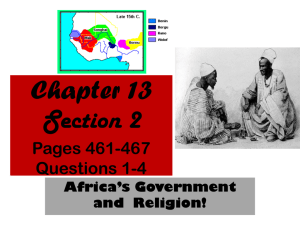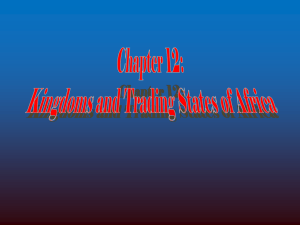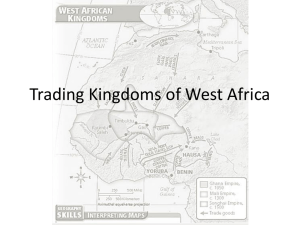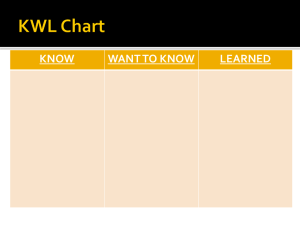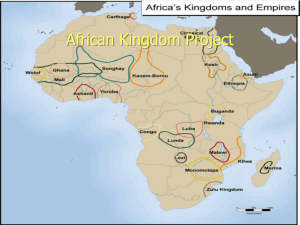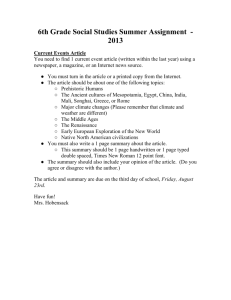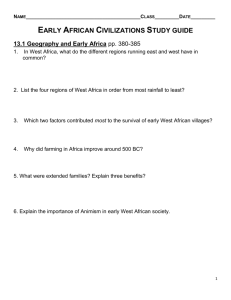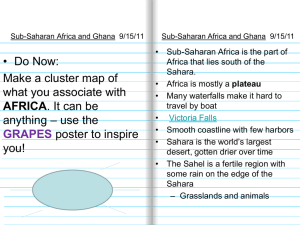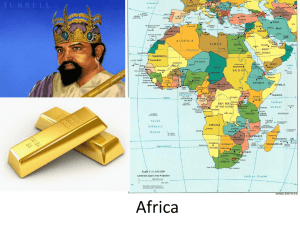chap12powerpoint
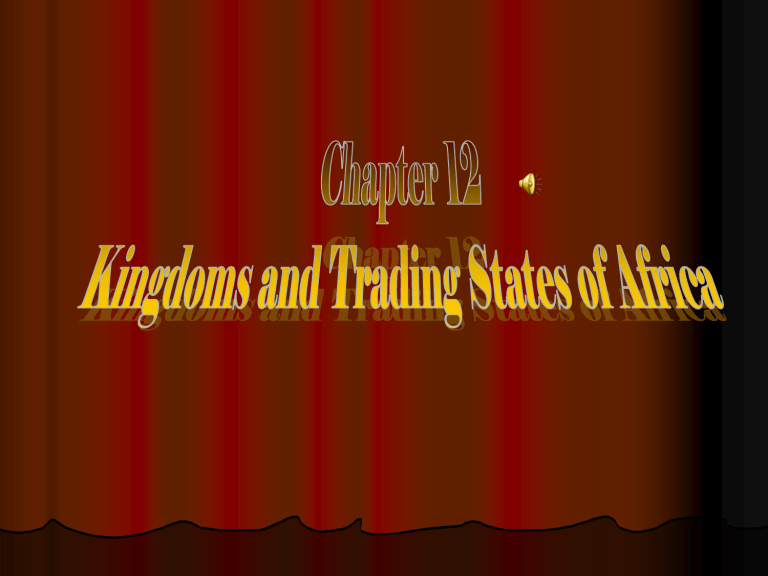
Ge graphy of Africa
• Tropical rainforests cover less than 5% of the land.
The rainforests have thick vegetation and a heavy amount of rain which makes it very moist.
• Africa’s largest and most populated climate zone is the savanna, or grassy plains. The savanna generally has good soil and enough rainfall to support farming.
• Another climate zone in Africa is the desert. The Sahara, in northern Africa, is the biggest desert in the world. The desert is very dry therefore, farming is almost impossible.
• Along the Mediterranean coast of
Africa, and at the tip of southern
Africa, there is fertile farmland called the Mediterranean
Climate. Unlike the desert, the
Mediterranean Climate is ideal for farming.
Over thousands of years, migrations contributed to diversity of African people and their cultures. West
African farmers and herders moved to the south and east between
500 and 1500 AD. They spoke a variety of languages that all came from the African root language, Bantu.
The ancient kingdom
Nubia was formed on a wide band of fertile land along the Nile. Nubian rulers adopted many
Egyptian traditions. They built palaces and pyramids modeled on
Egyptian styles.
The Romans built roads, dams, aqueducts, and cities across North Africa. From
North Africa, they imported lions and other fierce animals to do battle with the gladiators. By 200
A.D., camels had been brought to North Africa from Asia. The camels revolutionized trade across the Sahara because they can carry heavy loads for a long time with little or no water.
Kingdoms Of West Africa
Mali, Ghana, and Songhai were among the richest of the
West African states. They dominated the Sahara trade.
Two products that dominated the Sahara trade were gold and salt. These commodities, or valuable products, were plentiful.
Sahara Trade Routes
Ghana Mali Songhai
In A.D. 800 the rulers of the Soninke people united many farming villages to create Ghana.
It was called “the land of gold.” The capitol of
Ghana was Kumbi Saleh which was comprised of two separate towns.
Muslim merchants brought their Islamic faith to Ghana. They also introduced their written language coinage, buisness methods, and architecture. In time
Ghana was overtaken by
Mali.
Sundiata founded the kingdom of Mali.
Mali’s kings were called mansas. The greatest emporer of
Mali, Mansa Musa, expanded Mali’s borders and worked to keep peace. He converted to Islam and actually fulfilled one of the five pillars of Islam by making the hajj. He formed diplomatic and economic ties with other Muslim states, increasing Mali’s renown.
Gao, a wealthy trading state became the capital of Songhai. It’s leader,
Sonni Ali, made it the largest state to have ever existed in West
Africa. He followed traditional beliefs. After his death Askia
Mohammed set up a
Muslim dynasty and set up a bureaucracy. He also completed the hajj which improved his ties with the Muslim world.
After the fall of Songhai this part of West Africa splintered into many small kingdoms
GOLD SALT
Two products, gold and salt, dominated the Sahara trade.
Gold was plentiful in present day Ghana,
Nigeria, and Senegal which is in West
Africa. They would trade their gold for salt with South Africa. South Africa was in need of gold and West Africa was in need of salt.
Salt was very important. People needed salt in their diet to prevent dehydration, especially in hot, tropical areas.
The most common religion in Africa was Islam. Islam spread slowly at first but in 1050, the
Almoravids, who were Muslims of
North Africa, launched a campaign to spread
Islam.
One of the greatest emperors , Mansa
Musa, fulfilled one of the five pillars of
Islam and made his pilgrimage to Mecca.
Wherever he stopped on his way, he spread his generosity and gave the people there goods and gold.
By 1000 A.D., port cities in
Africa were thriving from trade across the Indian ocean. Some of the things that were produced in
Africa that they traded were ivory, rhinoceros horn, hides, and gold. Some immediate affects from the trading were that there was thriving commerce in Mogadishu, Kilwa, and Sofala. There was also a rise of strong East African city-states and a rise of slave trade. There was also the introduction of crops and animals from the
Middle East and Asia.
To the south and inland from the coastal citystates, massive stone ruins sprawl across rocky hilltops near the great bend in the
Limpopo River.
These ruins are known as
“Great Zimbabwe.” The builders of Great
Zimbabwe were a group of Bantu-speaking people who settled in the region between 900 and 1500.
The newcomers brought improved farming methods. They produced enough food to support a growing population.
Zimbabwe reached its height in about 1300. By then, it tapped nearby gold resources and created profitable commercial links with coastal cities like Sofala.
Scholars have suggested that the ruler of Great
Zimbabwe was a god-king who presided over a large court. A central bureaucracy ruled an inner ring of province, while appointed governors had authority in more distant villages.
Bantu people migrated across Africa.
Whenever they settled, they adapted to local environments. They had different groups serving different purposes in their villages. One of the groups included hunter and food gatherers. They would hunt animals and gather wild plants and roots. Another group was the herders and fishers. Their jobs were to trap fish in the rivers and to herd animals such as cattle. The last group is the farming societies. They farmed a variety of crops from grains to bananas. Most farmers used a method called slash-and-burn agriculture. They cleared forest and brush land with iron axes and then burned the remains, using the ash for fertilizer.
African art was usually created in ivory, bronze, and wood. Jewelry and dyed cloth was used in African art often.
Much art, though, served as social and religious purposes.
Regents Questions
1)
The wealth and power of Mali’s ruler, mansa musa, were significant because they contributed to the a) Start of the crusades c) Spread of Islam b) Growth of European nationalism d) Rise of Arab nationalism
2) The spread of Islam into the kingdoms of Ghana and Mali resulted from a) Imperialism c) cultural diffusion b) Ethnocentrism d) self- determination
3) Which civilization best completes the heading of the partial outline
1) Benin
2) Mali
3) Kush
4) Egyptian
____________ a)spread of Islam b)Gold and salt trade c) Growth of Timbuktu d) Pilgrimage of Mansa Musa
Regents Questions
4) Which description best characterizes the city of
Timbuktu a) Port of the water route to east
Asia b) Major urban and industrial center on the Silk road c) Commercial and cultural center of West Africa d) Inland city of the Hanseatic league
5) Which economic activity was the basis for most of the wealth and power of the West African empires of Ghana and Mali a) Hunting and gathering b) Farming and cattle ranching c) Trading in salt and gold d) Working in bronze and brass
Answers
1) c. the spread of Islam
2) c. cultural diffusion
3) c. Mali
4) c. commercial and cultural center of West Africa
5) c. trading in salt and gold
